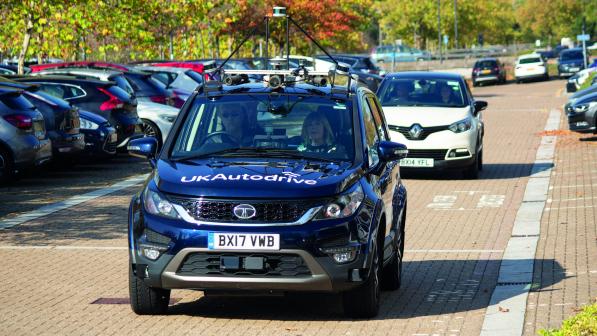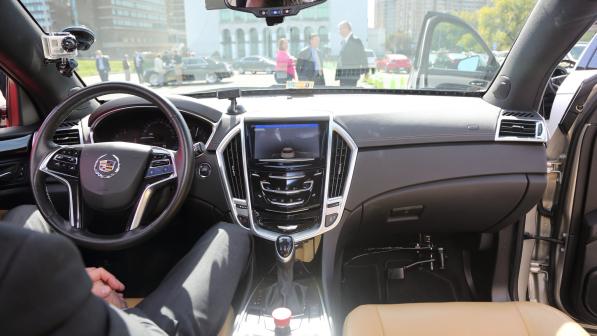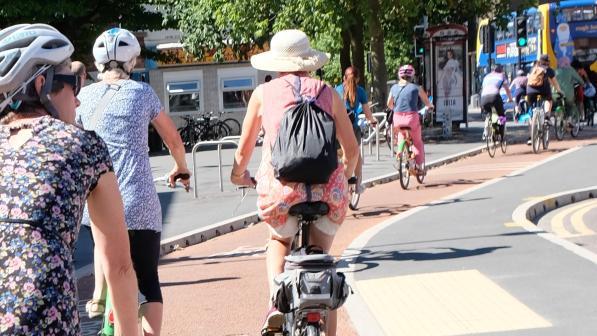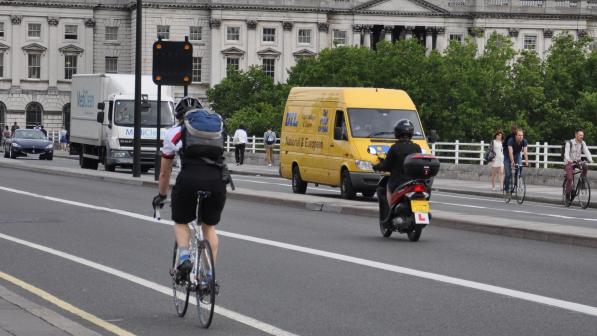What needs to be done to make sure that autonomous vehicles don’t put cyclists and pedestrians at risk?

The Society of Automotive Engineers (SAE) has identified six levels of automation, moving from no assistance to full automation (no need for human input).
Some vehicles (Levels 1 and 2) offering partial automation (which the Department for Transport (DfT) calls ‘Advanced Driver Assistance Systems’ or ADAS), are already on the market. They offer, for example, lane control devices, advanced cruise control and automated emergency braking.
ADAS still require the driver to pay attention at all times, but are gradually becoming better at handling more and more of the driving task. A few existing vehicles are already being promoted almost as semi-autonomous systems (‘conditional automation’ or Level 3).
Impact on safety
The table below sets out SAE’s six levels of automation and the term the Department for Transport (DfT) uses for them. We’ve also assessed the time frame and impact on safety in the right-hand columns:
SAE level
Vehicle characteristics
DfT term
Time frame*
Impact on safety*
0
No assistance for the driver
Current
Status quo (220k injuries/year)
1
Driver assistance – either assisted steering (lane control) or acceleration/deceleration (emergency braking)
ADAS
Some current vehicles
Possibly fewer incidents of rear ending
Risk of driver reliance on safety features
2
Partial automation – multiple systems providing driver assistance
ADAS
A few existing vehicles
Possibly fewer incidents of rear ending
Risk of driver reliance on safety features
3
Conditional automation – optional full automation with driver required to be ready to resume control
AV
In testing. Close to market
Potentially high risk if a distracted driver has to take over in risky situation
4
High automation – vehicle can achieve nearly all driving tasks independently, but driver input is optional
AV
Some companies claim it will be ready by 2021
Risk likely to be eliminated from controlled roads (motorways), but could be increased where drivers have to resume control, e.g. on rural or urban minor roads
5
Full automation – vehicle has complete autonomy and requires no human input
AV
>2025, with total fleet coverage decades thereafter
Likely to resolve 90-95% of traffic crashes with mature technology and full market penetration
*Impacts and time frame as assessed by Cycling UK. For more on the six levels, see page 14ff of the House of Lords Science and Technology Select Committee's report Connected and Autonomous Vehicles (March 2017).
The dangers of semi-autonomous systems
Using a human driver to supervise a semi-autonomous system is fraught with danger:
- Psychological research – and real-world examples – suggests that without the need to contribute to the driving task constantly, many supervising drivers quickly stop paying attention, and are unlikely to be ready to take control when the AV needs human input.[1]
- This means that, while ADAS may prove beneficial to those inside vehicles, they are unlikely to improve safety for pedestrians and cyclists outside. Indeed, in some cases inattentive driving could make the situation worse.
- This risk has already become apparent in a well-publicised case where a test driver allowed their AV to hit and kill a pedestrian who was walking their bike across a road in the USA.
What does the Government need to do?
- In the short term, the DfT must ensure that autonomous and advanced driver technologies are safe around pedestrians and cyclists before permitting their further use.
- It is absolutely essential, for example, that AVs can not only reliably detect vulnerable road users (VRUs), but predict their movements too. At present, cyclists are trained to negotiate for space with drivers and alert them to their intentions by using hand signals and making eye contact. If they are no longer able to do this, a safe and convenient alternative will need to be developed.
- In advance of the rapid uptake of these vehicles, laws also need to be in place to penalise operators of ADAS technology for misuse (see below).
- The Government must commit to a roadmap that skips Level 3 automation, where human control can be switched on and off. The House of Lords Science and Technology Committee, as well as many AV systems developers including Waymo and Ford advise this too.
- The benefits from AV technology will only begin to be realised for cyclists and pedestrians at Level 5 (and some Level 4 vehicles), vehicles that are not under human control. The DfT thus needs to clarify the large difference between driverless AVs and vehicles at Level 4 (or even Level 3), where the driver is still required either to supervise, or to take over outside a prescribed area.
The emergence of AVs: positive and negative scenarios
How markets, individuals and companies will respond to the emergence of AV technology (as distinct from ADAS) is an unknown. The future, however, can be shaped by regulation.
The positive scenario
Here, a fully regulated fleet of AVs quickly becomes first the dominant, then the only form of motorised traffic, with human-controlled vehicles disappearing.
Currently, lack of priority and hostile conditions are significant barriers to cycling, but with AVs regulated to travel at safe speeds and subjected to access restrictions in urban areas, pedestrians and cyclists will enjoy much higher priority and the overall environment will be far more pleasant for them.
Furthermore, road sharing between cyclists and vehicles will become easier and safer on more streets, removing the need for dedicated facilities in all places.
A rapid shift to AVs may also reduce the propensity to own a vehicle personally and, with the rise of more sophisticated ‘shared mobility platforms’, make car sharing more attractive.
As a result, more road space could be repurposed; redundant car parking space could be given over to cycling, for example. This would, again, have the potential to improve conditions for cycling substantially.
The negative scenario
In this scenario, autonomous technology is opposed by vested interests, is slowly adopted and ADAS instead becomes more widespread. Humans will still be in control of vehicles where they wish, a situation serving only to augment and ease the experience of drivers.
AVs will still emerge, but expected to follow and accommodate human driver behaviour, and pedestrians and cyclists will remain at risk.
What’s more, the mix of AV and human drivers will create an inherently chaotic system, making regulations to stop pedestrians and cyclists ‘disrupting’ traffic more likely.
And, with AVs making driving longer distances so straightforward and easy, weak regulation and planning may mean that new developments are allowed to sprawl to such an extent that walking and cycling both become less attractive.
The possible winners and losers from these scenarios are outlined in the table below.
Winners
Losers
Positive scenario
- Full AV fleet quickly adopted
- Personal car ownership replaced by car sharing
- The advent of AVs does not allow future cities to sprawl
- Human-controlled vehicles regulated off the public network within decades
- Service operators – on-demand public transport operators
- Everyone affected by crashes – most crashes between motor vehicles are eliminated
- Pedestrians and cyclists – they enjoy a greater sense of safety and the barriers to active travel are reduced
- Residents in areas blighted by traffic and parking – access restrictions more easily imposed through AV technology; most car parking space repurposed
- Public health – less pollution, fewer road casualties
- Workforce employed solely in driving – taxi and bus drivers, some freight operators
- Crash industry – manufacturers of vehicles and parts, repair workshops, insurers, lawyers
- ‘Keen drivers’ – individuals who enjoy operating their vehicles themselves (although they could still drive on private land)
Negative scenario
- Slow take-up of AV
- Model of car ownership continues
- Voluntary use of AV technology means distracted drivers
- Unplanned development means AVs used to facilitate urban sprawl
- Human-controlled vehicles still dominant, and set the debate
- Existing vehicle/crash industry – manufacturers of vehicles, parts, insurers, lawyers
- ‘Keen drivers’ – individuals who take satisfaction from retaining human control, and feel that this is a right
- Property developers specialising in suburban outskirts – sprawl development permitted as AV technology allows for longer trips (from home to work, shops, services)
- Workforce employed solely in driving – these workers will be most affected by even a moderate increase in AV
- All road users – road safety problems associated with interactions between AV and drivers
- Pedestrians and cyclists – demand remains supressed, and even regulated away from roads occupied by AVs
- Public health interests – few (or even fewer) people disposed to shift to active travel; and those who do are still at risk of injury
- Town centres and residential areas – still blighted by too much traffic and human drivers disobeying speed limits
Barriers to a positive AV scenario
There are various barriers that could prevent our positive AV scenario from coming to life:
- First and foremost, AV technology may never fully mature to the point that human drivers can be eliminated altogether. Some suggest that full Level 5 automation – necessary for this scenario to develop – will not become a reality until after 2030.
- In the push towards AV technology, companies and regulators both in the UK and elsewhere may begin a regulatory race to the bottom. Without proper safeguards, under-developed AV systems could be allowed too great a leeway to use the road network, placing other road users in danger.
- Without regulatory intervention, industries associated with the existing personal motor vehicle industry and allied interests may not voluntarily remove human-controlled vehicles from sale. As a result, the dangerous, negative aspects of AV technology will predominate.
- A road environment shared by both AV and human drivers could face huge practical problems. AVs might perhaps end up operating well below their optimum efficiency simply to accommodate human drivers.
- For instance, AVs operating by themselves could run in close proximity on very narrow roadways, freeing up road capacity for other uses, including cyclists; human drivers, on the other hand, would still require the same space for careless manoeuvring and other errors, for which AVs would have to leave extra room. Junction capacity would similarly have to be hugely reduced to cater for human skills.
AVs, active travel, sustainability and public health
In theory, AVs could make motorised travel even more affordable than it is presently, eroding more sustainable modes such as walking and cycling.
To stop this happening, the Government must plan holistically for AVs, making sure that it’s a matter of clear policy to improve public health and the environment by preserving and enhancing conditions for active travel.
Accountability and regulation: mechanisms to properly govern AVs and ADAS systems
As mentioned, we fear that there is considerable potential for AV systems to increase risk, particularly for pedestrians and cyclists who may not be detected by crude sensors.
Civil liability
The Government has already passed the Autonomous and Electric Vehicles Act 2018.
Part one of the Act sets out, in broad parameters, how AVs involved in collisions will be treated for insurance purposes. The Government wants to extend the principle that all drivers must cover themselves with third-party liability insurance to AVs when the car is the driver and the ‘driver’ sometimes a passenger.
In the event of a collision, individuals claiming compensation will still go through the motor insurance settlement framework, rather than a product liability framework against an AV manufacturer.
Criminal legislation
Cycling UK believes that legislation is needed to determine who is legally responsible for declaring AV technology safe, and who is accountable in the case of a crime.
We suggest that the following changes are required as a minimum:
- Road Traffic Act 1988 amended to bring misuse or tampering with AV technology within the definition of dangerous driving (this should be considered as part of a holistic review of careless and dangerous driving offences)
- Legislation amended or introduced to:
- ensure that there is a legal entity responsible for incidents involving AVs
- include AV sensors within Construction and Use Regulations
- ensure that data from AVs are readily accessible to law enforcement officials both remotely, and directly from the vehicle (see below)
In addition to changes in the laws themselves, their enforcement also needs to be restructured so that it can apply to manufacturers and operators, as well as drivers.
The Law Commission has been asked to undertake a far-reaching review of the UK’s legal framework for automated vehicles, a move that Cycling UK has welcomed.
Using traffic laws to improve the environment for walking and cycling
AV technology will also help traffic laws achieve much wider objectives. For instance, much more attractive road conditions for pedestrians and cyclists would be created by heavily restricting access to town or city centres or residential areas, and enforcing height and weight limits.
Speed limits are currently set using a combination of existing speeds and the desired maximum, acknowledging that some drivers will – intentionally or otherwise – disregard speed limits. AV technology, though, allows for speed limits to be set at levels entirely appropriate to the environment in question: perhaps 10 or 15 mph on most residential streets.
Cycling UK believes that, in readiness for AVs, the DfT must provide a much wider array of possible solutions for lower speed limits and access arrangements.
Data sharing
Sharing data relating both to individuals and vehicles is likely to become a highly contested issue.
This means that the Government must carefully consider and develop clear, unambiguous arrangements covering how data are to be shared between operators, insurers and enforcement agencies.
This needs to safeguard users’ privacy, but at the same time make sure that road traffic law can still be enforced, and other criminal activities counteracted.
[1] Carr, N. The Glass Cage: Automation and Us. 2014. New York: W.W. Norton & Company, p. 91.






